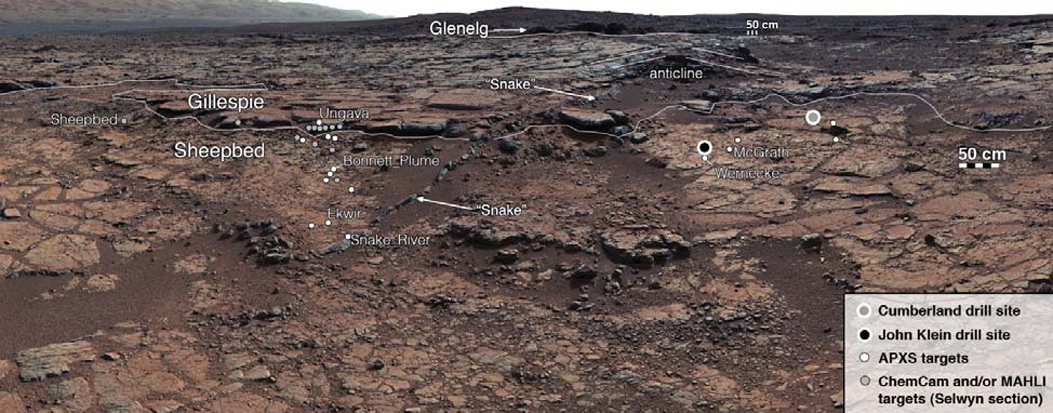Ancient Mars Lake Could Have Supported Life, Curiosity Rover Shows

NASA's Curiosity rover has found evidence of an ancient Martian lake that could have supported life as we know it for long stretches — perhaps millions of years.
This long and skinny freshwater lake likely existed about 3.7 billion years ago, researchers said, suggesting that habitable environments were present on Mars more recently than previously thought.
"Quite honestly, it just looks very Earth-like," said Curiosity lead scientist John Grotzinger, of the California Institute of Technology in Pasadena. [Ancient Mars Could Have Supported Life (Photos)]
"You've got an alluvial fan, which is being fed by streams that originate in mountains, that accumulates a body of water," Grotzinger told SPACE.com. "That probably was not unlike what happened during the last glacial maximum in the Western U.S."
Habitable Mars
The lake once covered a small portion of the 96-mile-wide (154 kilometers) Gale Crater, which the 1-ton Curiosity rover has been exploring since touching down on the Red Planet in August 2012.
The new results, which are reported today (Dec. 9) in six separate papers in the journal Science, confirm and extend Curiosity's landmark discovery, painting a more complete picture of the Yellowknife Bay area long ago.
Breaking space news, the latest updates on rocket launches, skywatching events and more!
This picture emerged from Curiosity's analysis of fine-grained sedimentary rocks called mudstones, which generally form in calm, still water. The rover obtained powdered samples of these rocks by drilling into Yellowknife Bay outcrops.
The mudstones contain clay minerals that formed in the sediments of an ancient freshwater lake, researchers said. Curiosity also spotted some of the key chemical ingredients for life in the samples, including sulfur, nitrogen, hydrogen, oxygen, phosphorus and carbon.
The lake could have potentially supported a class of microbes called chemolithoautotrophs, which obtain energy by breaking down rocks and minerals. Here on Earth, chemolithoautotrophs are commonly found in habitats beyond the reach of sunlight, such as caves and hydrothermal vents on the ocean floor.
"It is exciting to think that billions of years ago, ancient microbial life may have existed in the lake's calm waters, converting a rich array of elements into energy," Sanjeev Gupta of Imperial College London, co-author of one of the new papers, said in a statement.
The shallow ancient lake may have been about 30 miles long by 3 miles wide (50 by 5 kilometers), Grotzinger said. Based on the thickness of the sedimentary deposits, the research team estimates that the lake existed for at least tens of thousands of years — and perhaps much longer, albeit on a possibly on-and-off basis.
Taking into account the broader geological context, "you could wind up with an assemblage of rocks that represent streams, lakes and ancient groundwater systems — so for times when the lake might have been dry, the groundwater's still there. This could have gone on for millions or tens of millions of years," Grotzinger said.
The lack of weathering on Gale Crater's rim suggests that the area was cold when the lake existed, he added, raising the possibility that a layer of ice covered the lake on a permanent or occasional basis. But such conditions wouldn't be much of a deterrent to hardy microbes.
"These are entirely viable habitable environments for chemolithoautotrophs," Grotzinger said.
Researchers still don't know if the Gale Crater lake hosted organisms of any kind; Curiosity was not designed to hunt for signs of life on Mars. But if chemolithoautotrophs did indeed dominate the lake, it would put an alien twist on a superficially familiar environment.
"You can imagine that, if life evolved on Mars and never got beyond the point of chemolithoautotrophy, then in the absence of competition from other types of microbes, these systems might have been dominated by that type of metabolic pathway," Grotzinger said. "And that's an un-Earth-like situation."
Follow Mike Wall on Twitter @michaeldwall and Google+. Follow us @Spacedotcom, Facebook or Google+. Originally published on SPACE.com.

Michael Wall is a Senior Space Writer with Space.com and joined the team in 2010. He primarily covers exoplanets, spaceflight and military space, but has been known to dabble in the space art beat. His book about the search for alien life, "Out There," was published on Nov. 13, 2018. Before becoming a science writer, Michael worked as a herpetologist and wildlife biologist. He has a Ph.D. in evolutionary biology from the University of Sydney, Australia, a bachelor's degree from the University of Arizona, and a graduate certificate in science writing from the University of California, Santa Cruz. To find out what his latest project is, you can follow Michael on Twitter.

